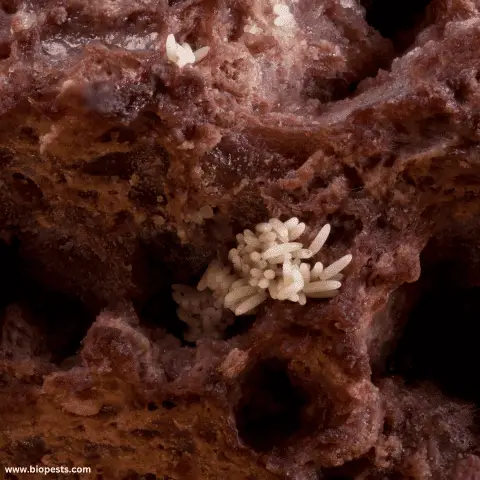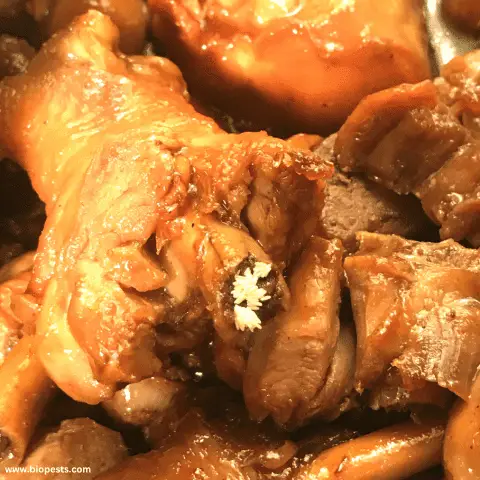Did you know that flies are one of the most adaptable species in the animal kingdom? Their remarkable ability to survive brings them dangerously close to our meals, posing a real risk to our well-being. By understanding the fly life cycle, their reproduction habits, and what attracts them to our food, we can gain valuable insights into this widespread issue. What’s more, the eggs they lay can even spread diseases and infections – a concerning reality that calls for urgent action. Learn about preventative measures, detection techniques, and proper food handling to effectively reduce the risk of infestations.
Why Flies Lay Eggs On Food?
Flies have a smart strategy when it comes to ensuring the survival and growth of their young. They lay their eggs on food for two important reasons: immediate nourishment and growth opportunities. While adult flies are capable of finding their own food, their wingless larvae heavily rely on the surrounding environment for sustenance. It’s a fascinating cycle of life where food plays a vital role in the journey from egg to adult fly.
The life cycle of a fly involves four primary stages: egg, larvae (maggots), pupa, and adult.
After mating, female flies tend to lay their eggs on food and organic matter, ideally rotting or decaying substances. The placement of eggs ensures a food source, which is crucial for their offspring. These eggs, white in color and roughly the size of a grain of rice, hatch into larvae within 24 hours. Over the next few days, the larvae consume the food source, subsequently growing and molting twice before transitioning into the pupa stage.
Inside the pupal case, it metamorphoses into an adult fly – a process that usually takes around three to seven days.
Nourishment is best provided by decaying or rotting substances, which is why flies are attracted to garbage bins, compost heaps, and food waste. They lay their eggs in these areas to ensure the survival and growth of their offspring. However, this behavior can spread bacteria and viruses if humans or animals consume contaminated food. Therefore, storing food properly and effectively controlling fly infestations is crucial to prevent health risks.

Health Risks Associated with Fly Eggs on Food
Consumption of food infested with fly eggs might pose serious health risks. Flies, known for visiting contaminating waste materials or rotting food, can carry detrimental microorganisms, such as E. coli, Salmonella, and Campylobacter. They transmit these organisms to food when laying their eggs, which can cause foodborne illnesses if ingested. The symptoms can range from mild digestive problems like vomiting or diarrhea to severe food poisoning requiring hospital assistance.
Another linked risk involves certain fly species that can cause myiasis, a condition where fly larvae develop within human tissue. Even though this is uncommon, especially in developed areas, it still poses a potential risk. The maggots or larvae hatch quickly from the eggs, and if unintentionally ingested, there is a slim chance that they could survive in the human body, causing severe health problems.
However, practicing proper food handling and storage techniques can greatly reduce these risks and keep you safe.

Protect Your Food: 7 Essential Tips to Keep Flies Away
Fly egg contamination is a risk you don’t want to take. Follow these simple steps to keep flies away and ensure your food stays safe and fresh.
- Store Smart: Always use airtight containers and refrigerate perishable items. Don’t let flies have a chance to feast on your food.
- Cover Up: Never leave food uncovered when it’s out in the open. Flies love to land and contaminate your meals.
- Use fans against flies to keep them away from your dining area.
- Trash Tactics: Dispose of garbage regularly and secure trash cans tightly. Flies are attracted to decaying organic matter, so don’t give them a reason to stick around.
- Nix the Breeding Grounds: Keep stagnant water to a minimum and ensure clean and covered drains. Flies love to lay their eggs in these areas.
- Seal Them Out: Install screens on windows and doors to keep flies from entering your home. A simple barrier can make a big difference.
- Trap and Control: If necessary, consider using insect traps or ultraviolet light traps to help control fly populations. Take charge and keep those pesky flies at bay.
Don’t let flies ruin your meals. Take action now to protect your food and keep your home fly-free.
Keeping it Clean: A Foolproof Way to Detect Fly Egg Contamination
Prevent food contamination and health risks by efficiently detecting and removing fly eggs.
Use a magnifying glass to easily spot tiny, rice-shaped fly eggs on the surface of your food. These eggs are usually white or cream and are often found in clusters. Additionally, maintaining a high standard of cleanliness in your kitchen will deter flies from taking up residence. Regularly clean your kitchen surfaces with powerful disinfectants to eliminate potential eggs or larvae. Don’t forget to clean behind appliances and ensure no food particles are left behind. Keeping your environment clean greatly reduces the risk of attracting flies and experiencing a fly infestation.
Attention parents with small babies: Don’t forget to clean under your baby’s seat cushion! It’s important to remove any food debris that may have fallen and could be deteriorating in that hidden spot.

A Guide on Identifying Entry Points and Repelling Flies
As the weather warms up, we deal with an unpleasant and frustrating issue – pesky flies in our home. These insects not only threaten our comfort but can also carry harmful bacteria and germs. However, taking some simple steps can help keep these unwanted guests at bay.
Firstly, it’s essential to know where flies are coming from. They tend to gather in areas with stagnant water or moist soil, so check for leaks or standing water around your home. Additionally, flies are attracted to food, so keep an eye on pet food or other outdoor dining areas and clean up any mess regularly. Once you’ve identified the areas where flies congregate, it’s time to tackle the issue head-on.
Investing in a fly catcher or repellent can effectively keep flies away from your home. There are various options on the market, including sticky traps, light traps, and ultrasonic repellents.
An effective solution to get rid of pesky flying insects that keep buzzing around your head is this state-of-the-art bug zapper! Engineered with the latest technology, this bug zapper promises to deliver unmatched performance in trapping and killing mosquitos, flies, and any other flying insect that may be bugging you.
Not only the ASPECTEK bug zapper fully functional and highly efficient, but it’s also designed to be aesthetically pleasing, blending in seamlessly with your indoor and outdoor decor. Plus, its compact size makes it easy to use and transport, so you can take it anywhere you go – from camping trips to the backyard BBQ.
Boasting a powerful electric grid that attracts and zaps flying insects, our bug zapper eliminates the need for messy and harmful chemicals that can be both hazardous to your health and the environment. Say goodbye to smelly bug spray and sticky fly traps and hello to a cleaner, greener bug control solution!
Give this bug zapper a try today! Trust me – you won’t be disappointed.

In addition to commercial fly catchers or repellents, there are also natural deterrents that can be utilized. Essential oils such as peppermint, citronella, and eucalyptus can be effective fly repellents. Mix a few drops of these oils with water and spritz around your home for an added layer of protection. You can also use natural sprays that contain these oils to keep flies at bay. Spraying citrus or lavender scent around your home can also help repel flies and provide a refreshing aroma inside your house.
Keeping your doors open to allow fresh air into your home may be tempting, but it could be one of the main entry points for flies. It is essential to keep doors closed whenever possible to prevent these pests from entering your home. Moreover, you may want to consider sealing any cracks and crevices around doors and windows. This can be done with weather-stripping.
Conclusion
Protecting our health and ensuring a safe environment doesn’t have to be difficult. We can reduce our risk of fly infestations by implementing effective precautions, adjusting our food handling habits, and maintaining cleanliness. But it doesn’t end there. It is crucial to understand the habits and life cycle of flies, their potential health risks (especially through their eggs), and how to detect and prevent contaminations. With this knowledge, we can create a safer shared environment for everyone, keeping our food safe and improving our quality of life.
Some of the links above are affiliate links, meaning at no additional cost to you, I will earn a commission if you click through and make a purchase.

